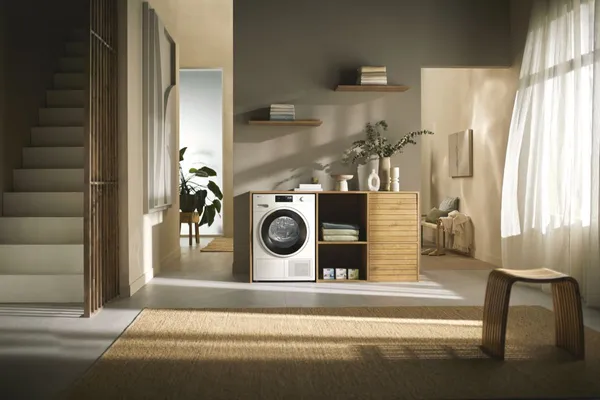Ventless Dryer Pros and Cons: Everything You Need to Know

Ventless dryers are a modern alternative for handling laundry, especially in homes without a standard laundry setup. Instead of relying on outdoor drying or bulky vented machines, this compact option offers a convenient way to save space. With SD Appliance Repair’s professional guidance, you can choose the right unit and have it properly installed. Here’s a breakdown of the key advantages and drawbacks to consider before deciding if a ventless dryer is the right fit for you.
What Is a Ventless Dryer?
- A ventless dryer operates without the need for an outside exhaust system. Rather than pushing hot, moist air outdoors, the machine keeps the air moving within the unit to dry laundry. These dryers generally come in two main designs:
- Condenser models draw in room air, heat it, and circulate it through the drum. The moisture removed from clothes turns into water inside a heat exchanger, which is then collected in a removable reservoir that must be emptied.
- Heat pump models are more energy-efficient and rely on a heat pump system to warm the air that circulates. As the damp air passes through an evaporator, the moisture condenses into water, which is either drained or pumped away. The remaining dry air is then reheated and reused in the cycle, making the process both efficient and eco-friendly.
|
Pros of Ventless Dryers |
Cons of Ventless Dryers |
| Works in any room |
Smaller capacity |
| Energy efficient |
Long drying cycles |
| Easy to install |
High up-front cost |
| Less maintenance |
Creates humidity |
Pros of Ventless Dryers
One of the biggest advantages of ventless dryers is their simple setup and low maintenance needs. They’re especially popular in compact living spaces, such as apartments or small houses, where traditional venting systems or dedicated laundry rooms aren’t an option. Below are some of the main benefits they offer.
1. Works in Any Room
The biggest advantage of a ventless dryer is its flexibility in placement. Since it doesn’t rely on ducts, you’re not limited to a basement or a full laundry room. This makes it an ideal option for compact living spaces like apartments or smaller houses. Because of their reduced size, these dryers can fit neatly into areas such as a spare closet or even a corner of the kitchen.
2. Energy Efficient
Ventless dryers use energy more effectively by reusing the warm air inside the machine instead of constantly drawing in fresh air and expelling damp air outside. Among them, heat pump models stand out for their efficiency, often using up to half the electricity required by conventional dryers.
3. Easy to Install
Compared to standard dryers, ventless models are much simpler to set up. All that’s required is a power source and adequate ventilation around the unit to keep it operating safely. Since no duct system is necessary, you avoid the high expense of adding new ventilation, which makes these dryers especially practical for older houses without modern HVAC infrastructure.
4. Less Maintenance
Although ventless dryers will eventually need repairs as components age, they don’t require the upkeep of duct systems. Routine care mainly involves clearing lint from the filter after each load, occasionally wiping down internal parts, and draining the water tank when it fills.
Cons of Ventless Dryers
The drawbacks of a ventless dryer are mostly connected to its capacity and performance. SD Appliance Repair. Although it’s a practical choice for compact areas where ducts aren’t available, it may not always be the most suitable option for every household.
1. Smaller Capacity
Because ventless dryers are typically more compact than standard models, they aren’t designed to handle oversized loads. For households with many members, this can mean doing multiple cycles, which adds extra time to laundry routines.
2. Longer Drying Cycles
Clothes usually take longer to dry in a ventless unit compared to a standard dryer, with an average cycle lasting around an hour and a half. This slower process is due to the recirculation of air within the machine. Heat pump versions are even gentler, using lower temperatures that protect fabrics but extend drying time.
3. Higher Up-Front Cost
Although ventless dryers save money on installation by eliminating the need for venting, the appliances themselves tend to be pricier than conventional dryers. Mid-range models typically fall in the $1,040 to $2,040 range, while some basic, less expensive options are also available.
4. Higher Humidity
Because ventless dryers don’t release air outdoors, they can raise indoor humidity levels. In compact areas, this extra moisture may encourage mold or mildew, so it’s best to place the dryer in a space designed to handle dampness, such as a kitchen or bathroom.
Alternatives to Ventless Dryers
Other dryer options are available if a ventless model isn’t ideal for your needs. The standard choice is a vented dryer, usually powered by electricity, though gas-powered versions are also an option. Gas models tend to use more energy but can handle bigger loads and dry clothing faster.
For tighter spaces, an all-in-one washer-dryer may be a good fit. These machines combine washing and drying in a single unit, eliminating the need for a separate dryer or vent, though drying cycles generally take longer.
You Appliance Will Be Fixed!
in San Diego, CA
REQUEST SERVICE
Book a Repair Appointment

